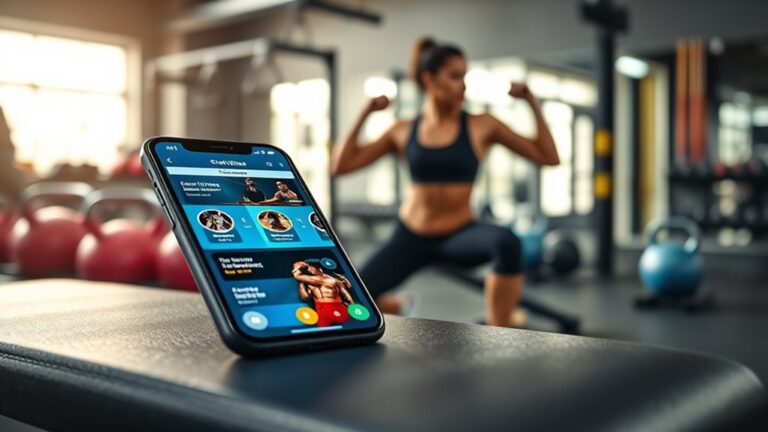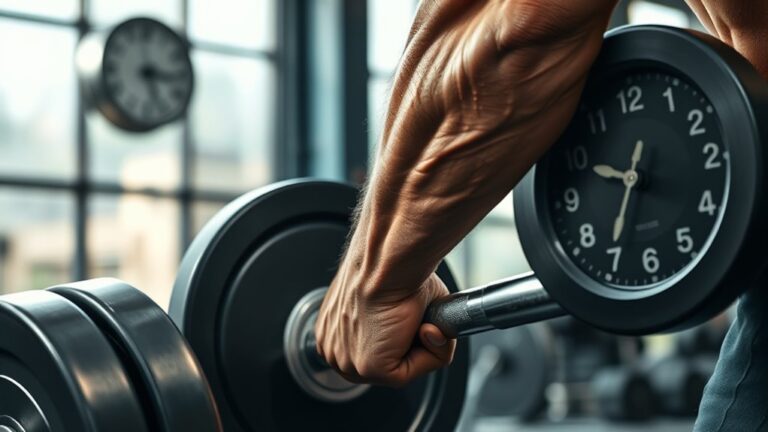The Best NBA Strength Training Workouts
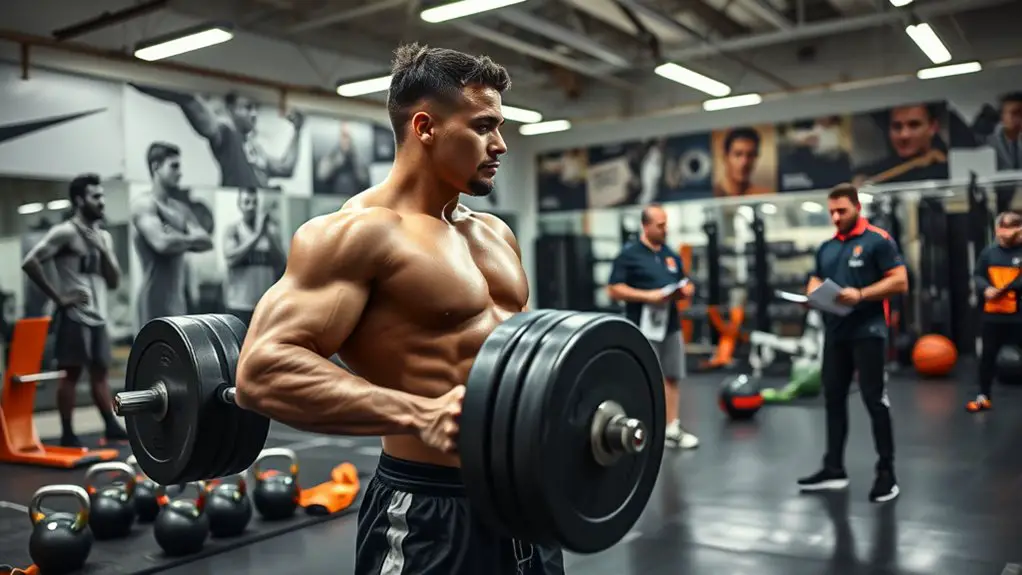
To elevate your game, focus on strength training workouts that target key muscle groups. You’ll want to include lower body exercises like plyometric jumps and resistance band squats, along with core workouts such as planks and lateral bounds. Upper body strength is essential, too, so incorporate exercises like bench presses. Don’t forget about agility drills to complement your strength. Stick around to discover more strategies that can enhance your performance on the court.
Importance of Strength Training in Basketball

While you might think skill and agility are the only keys to success on the court, strength training plays an essential role in elevating your game. Embracing a strength training routine not only boosts your physical power but also enhances your overall performance. You’ll notice increased explosiveness when jumping, allowing you to dunk with ease or block shots effectively.
Moreover, strength training benefits your endurance, enabling you to maintain peak performance throughout the game. It builds resilience against injuries, which is important for longevity in your basketball career. By developing an athlete mindset, you’ll push your limits, embracing challenges that come with lifting weights and conditioning.
This mental toughness translates directly to your approach on the court, making you more focused and determined. So, don’t overlook strength training; it’s a critical part of your journey to becoming the best player you can be.
Key Muscles to Target for Optimal Performance
To maximize your performance on the basketball court, it is crucial to target specific muscle groups that play a significant role in your game. Focusing on these key areas can lead to substantial performance enhancement, helping you become a stronger and more agile player.
| Muscle Group | Importance |
|---|---|
| Legs | Key for jumping, sprinting, and stability. |
| Core | Provides balance and power in movements. |
| Upper Body | Aids in shooting, passing, and defense. |
Core Workouts to Improve Stability and Balance

To enhance your stability and balance on the court, incorporating core workouts is essential. Plank variations and medicine ball exercises can greatly strengthen your midsection, giving you the foundation to outmaneuver opponents. Let’s explore these effective techniques that will elevate your game performance.
Plank Variations for Stability
Adding plank variations to your workout routine can greatly enhance your core stability and balance, which are essential for any aspiring NBA player. By incorporating plank progression, you’ll reap numerous stability benefits that can improve your on-court performance. Here are four effective plank variations to include:
- Standard Plank: Maintain a straight body line and engage your core.
- Side Plank: Shift your weight to one arm, stacking your feet for oblique strength.
- Plank with Shoulder Taps: Alternate tapping your shoulders while stabilizing your hips.
- Plank to Push-Up: Shift from a plank position to a push-up for added strength.
Integrating these variations will not only challenge your core but also boost your overall athleticism. Stay consistent, and you’ll see impressive results!
Medicine Ball Exercises
While many core workouts focus solely on bodyweight exercises, incorporating medicine ball exercises can greatly elevate your stability and balance, vital elements for any basketball player. Medicine ball slams are fantastic for developing explosive power while engaging your core. By lifting the ball overhead and slamming it down with force, you’ll enhance your strength and coordination.
On the other hand, medicine ball twists help improve rotational strength, important for shooting and passing accuracy. Sit with your knees bent, holding the ball, and twist your torso side to side, engaging your core throughout.
Regularly integrating these exercises into your training routine will not only boost your performance on the court but also reduce the risk of injury. Get started and feel the difference!
Lower Body Exercises for Explosive Power
As you endeavor to elevate your game on the court, incorporating lower body exercises for explosive power is vital. Focusing on building strength and speed in your legs will greatly enhance your performance. Here are four key exercises to include in your routine:
- Plyometric Jumps: These explosive movements improve your vertical leap and overall agility. Start with basic box jumps and progress to depth jumps for advanced training.
- Resistance Band Squats: Using resistance bands adds extra tension, engaging your muscles more effectively. Perform squats with bands around your thighs for greater resistance.
- Lateral Bounds: This exercise mimics the quick side-to-side movements in basketball, boosting your lateral explosiveness.
- Single-Leg Deadlifts: This unilateral exercise strengthens your hamstrings and improves balance, essential for explosive take-offs.
Incorporate these exercises into your regimen, and watch your game reach new heights!
Upper Body Strengthening for Enhanced Shooting
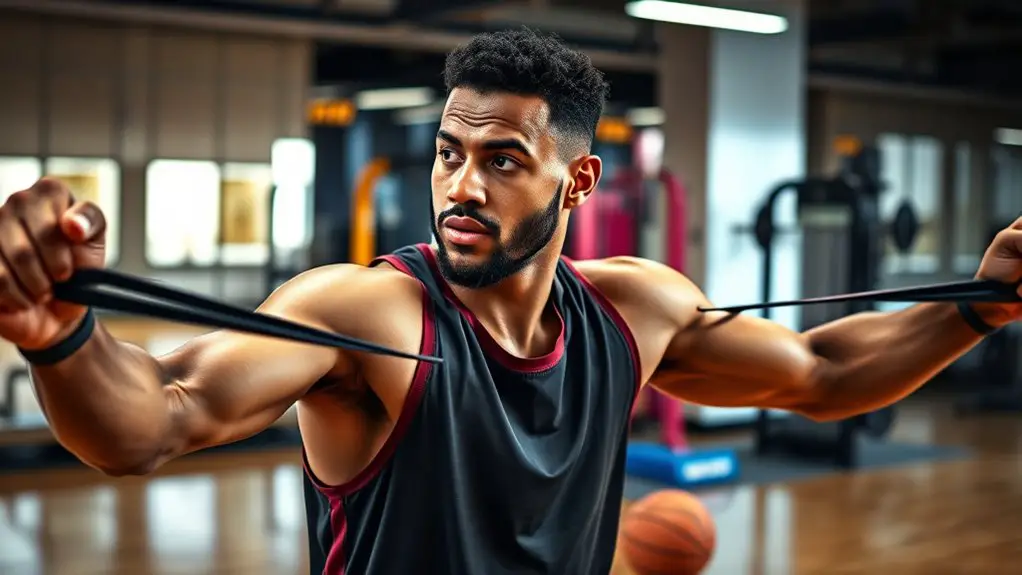
To elevate your shooting skills, strengthening your upper body is essential, since a powerful shot relies on the coordination of your arms, shoulders, and core. By enhancing your arm endurance and refining your shooting mechanics, you’ll achieve greater accuracy and consistency on the court. Here’s a quick reference table of effective upper body exercises:
| Exercise | Sets | Reps |
|---|---|---|
| Push-Ups | 3 | 10-15 |
| Dumbbell Shoulder Press | 3 | 8-12 |
| Bent-Over Rows | 3 | 10-12 |
| Medicine Ball Throws | 3 | 10-15 |
Incorporate these exercises into your routine to build strength and endurance. Remember, stronger arms lead to better shooting form, allowing you to release the ball with confidence and precision. Stay focused, work hard, and watch your shooting skills soar!
Agility Drills to Complement Strength Training
Strengthening your upper body is just one piece of the puzzle in becoming a well-rounded player. To truly excel on the court, you need agility to complement that strength. Incorporating agility drills into your training routine can enhance your quickness and coordination. Here are four effective drills to get you started:
- Agility Ladder Drills: Use the ladder to improve foot speed and coordination. Practice various patterns, like in-and-out or lateral shuffles.
- Cone Drills: Set up cones in a zigzag pattern and sprint through them, focusing on quick changes of direction.
- T-Drill: Place cones in a T shape and work on sprinting, side shuffling, and backpedaling to build versatility.
- Box Drill: Create a square with cones, and practice sprinting to each cone in quick succession for explosive movement.
Integrate these drills into your routine, and watch your game elevate!
Recovery Techniques to Prevent Injury
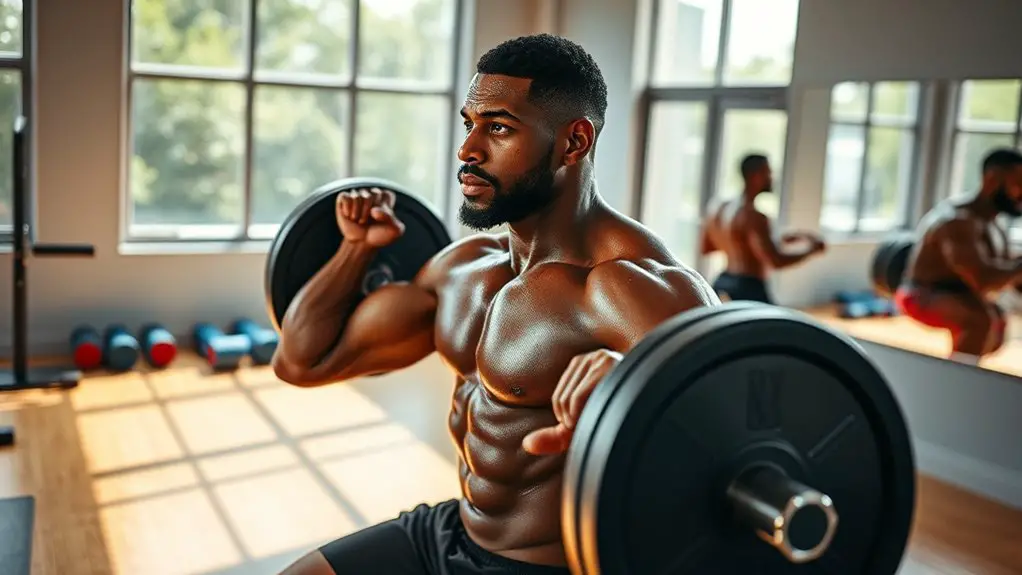
To maximize your performance and minimize injury risk, it’s vital to incorporate effective recovery techniques into your routine. Stretching and flexibility exercises, foam rolling, and proper hydration are essential components that can keep you in top shape. By prioritizing these elements, you’ll guarantee your body is ready for every challenge on the court.
Stretching and Flexibility Exercises
While you might focus on building strength and endurance on the court, neglecting stretching and flexibility exercises can undermine your efforts and increase your risk of injury. To enhance your performance and maintain your body, incorporate these crucial techniques:
- Dynamic stretching: Engage in movements like leg swings and arm circles to warm up and improve your range of motion.
- Static stretching: After workouts, hold stretches like hamstring and quadriceps stretches to lengthen your muscles and promote recovery.
- Post-game cool down: Spend 5-10 minutes cooling down with light stretching to aid in recovery.
- Consistency: Make stretching a regular part of your routine to guarantee flexibility and prevent tightness.
These exercises are essential for maintaining peak performance and protecting yourself from injuries.
Foam Rolling Benefits
Although you may already have a solid routine for strength training and stretching, incorporating foam rolling can greatly enhance your recovery and performance. Foam rolling techniques help release muscle tension, increase blood flow, and improve flexibility, which is essential for peak athletic performance. By using a foam roller regularly, you can target sore spots and knots in your muscles, allowing for quicker recovery after intense workouts. To maximize the benefits, aim for a foam rolling frequency of at least three times a week. This consistency not only helps prevent injuries but also prepares your body for demanding training sessions. Embrace foam rolling as a significant component of your regimen, and watch your performance soar!
Proper Hydration Importance
Proper hydration is essential for optimizing recovery and preventing injuries, especially when you’re pushing your limits on the court. Implementing effective hydration strategies and understanding hydration timing can greatly enhance your performance. Here are four key points to keep in mind:
- Pre-Game Hydration: Drink ample fluids leading up to your game to guarantee you’re starting hydrated.
- In-Game Hydration: Sip on water or electrolyte drinks during breaks to maintain energy levels.
- Post-Game Recovery: Rehydrate immediately after your game to replenish lost fluids and aid recovery.
- Daily Hydration Goals: Aim for at least half your body weight in ounces of water each day to support overall health.
Sample Strength Training Routine for NBA Players
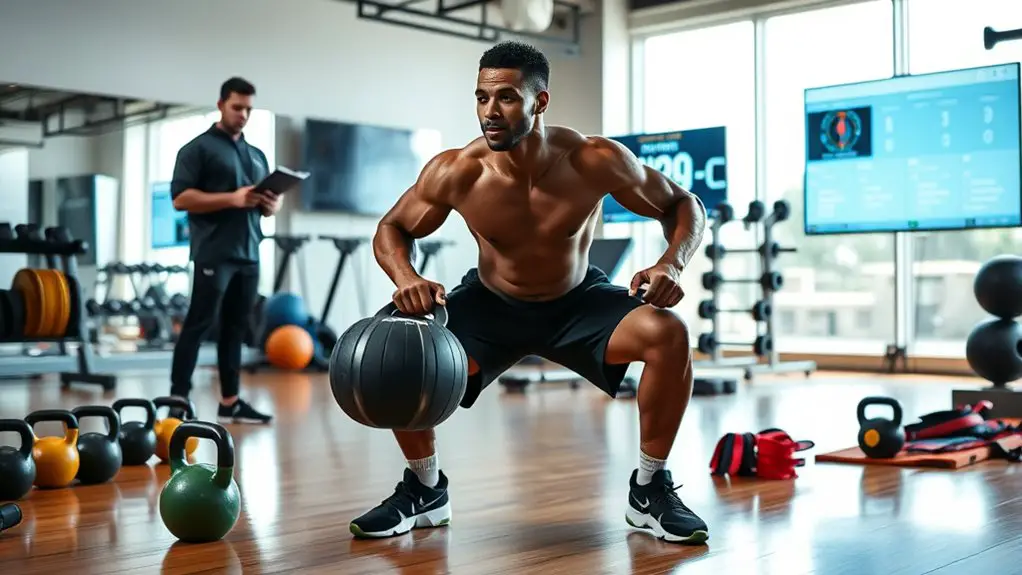
When you’re looking to elevate your game on the court, a well-structured strength training routine is essential for NBA players. Start with a balanced mix of compound exercises like squats and deadlifts, which target multiple muscle groups and build overall strength. Incorporate upper body lifts like bench presses and pull-ups to enhance your shooting and defensive capabilities.
Aim for a workout frequency of 3-4 times a week, allowing adequate rest to promote recovery and muscle growth. Each session should last about 60-90 minutes, including warm-ups and cooldowns.
Don’t forget to mix in plyometric exercises, like box jumps, to improve your explosiveness. Using these strength training techniques will not only boost your physical performance but also enhance your resilience against injuries. Stick to this routine, stay committed, and watch how it transforms your game on the hardwood!
Nutrition Tips to Support Strength Training Goals
To maximize your strength training results, it’s essential to fuel your body with the right nutrients. Proper nutrition not only supports muscle recovery but also enhances performance. Here are some key tips to focus on:
- Prioritize Nutrient Density: Choose foods rich in vitamins and minerals, such as leafy greens, lean proteins, and whole grains.
- Optimize Meal Timing: Eat a balanced meal or snack within 30 minutes post-workout to replenish glycogen stores and promote muscle repair.
- Stay Hydrated: Dehydration can hinder performance, so drink plenty of water throughout the day, especially around workout times.
- Include Protein: Aim for a source of protein in each meal to support muscle synthesis. Consider options like chicken, fish, or plant-based proteins.
Frequently Asked Questions
How Often Should NBA Players Strength Train Each Week?
Imagine you’re an NBA player like LeBron James, who strength trains around four to five times a week. For you, the ideal strength training frequency balances workout intensity and recovery needs. Hitting the gym too often can lead to burnout, while too little might not build the muscle you need. Aim for focused sessions that enhance your performance, ensuring you’re strong and agile on the court when it matters most.
What Equipment Is Essential for Strength Training Workouts?
When you’re looking to enhance your strength training workouts, having the right equipment is vital. Dumbbell exercises are a fantastic addition, as they offer versatility and target multiple muscle groups. Resistance bands are another essential tool; they provide variable resistance and can be used for a range of exercises, improving both strength and flexibility. Incorporating these tools into your routine will help you maximize your training and reach your fitness goals effectively.
Can Strength Training Improve My Vertical Jump?
Absolutely, strength training can greatly improve your vertical jump. By focusing on exercises that enhance your explosive power, you’ll develop the muscle strength needed for a higher vertical leap. Incorporating plyometrics and resistance training into your routine will help you build the necessary leg and core strength. Remember, consistency is key; the more dedicated you are, the better your results will be. Get ready to elevate your game and reach new heights!
Are There Specific Warm-Up Routines for Strength Training?
Imagine a well-oiled machine, each part moving seamlessly together. That’s what proper warm-up routines do for your body. To prepare for strength training, you should focus on dynamic stretching and mobility drills. These exercises enhance flexibility and range of motion, allowing your muscles and joints to perform at their best. By incorporating these elements into your warm-up, you’ll not only reduce the risk of injury but also maximize your strength training results. Let’s get moving!
How Do I Track My Strength Training Progress Effectively?
To track your strength training progress effectively, start by establishing clear progress metrics, like weight lifted, reps, and sets. Keeping a detailed training log is essential—record your workouts and any changes you notice in your body or performance. This not only helps in identifying trends but also keeps you motivated. Review your logs regularly; celebrate the small victories, and adjust your training plan as needed to guarantee continuous improvement and growth.



